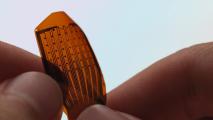In 1976, a grandmother took her two-year-old identical twin granddaughters to a crowded market in South Korea, but she only came back with one. The other sister was lost amid the throng. She was later found wandering alone and transported to a distant hospital where she was diagnosed with measles. Her family posted fliers and even appeared on a TV program to spread the news of her disappearance, but their best efforts to find her were for naught.
Placed with a loving foster family, the young girl was soon adopted by an American couple. She joined their household in the US two days before Christmas in 1976.
About 45 years later, the identical twins reunited after the American sister submitted a DNA sample as part of South Korea’s program for locating lost family members. Their story is now the focus of an intriguing scientific case study. As identical twins, the sisters share the same genes. So, how similar would they be given their remarkably different upbringings?
Identical genes, different environments
Two investigators, one in the US and one in South Korea, thoroughly interviewed the twin living in their respective country. Each sister was asked about her life history and her family environment, tested to measure various aspects of intelligence, and surveyed to gauge her personality, mental health, job satisfaction, and physical health.
Despite growing up in vastly different cultures and households, the identical twins shared very similar personalities, the researchers found. Both are hard workers, job-oriented, well-organized, enjoy playing sports, and strive for achievements. The Korean sister “was raised in a more supportive and cohesive family atmosphere where personal growth was encouraged. In contrast, the [American sister] was raised in a stricter, more religiously-oriented environment with higher levels of family conflict,” the researchers described.
In line with the differences in American and Korean cultures, the American sister expressed “the self as autonomous and believes that all members of a collective are of equal status,” while the Korean sister “perceives the self as a part of a collective, and accepts hierarchy and inequality within that collective.”
Consistent with their shared genetics, the identical twins were of a similar height and weight and both have diabetes. Both also had to undergo surgeries in their teen years to remove tumors from their ovaries.
The sharpest difference between the twins was in intelligence. The Korean sister outscored the American sister by 16 points on an IQ test. What explains this difference? While environment is one potential explanation, the study didn’t show that it necessarily was the cause. After all, partially explaining the variance is the fact that the American sister suffered three concussions as an adult, the most recent in 2018, which resulted in emotional changes and slight cognitive impairment.
The identical twins were overjoyed to be reunited. Both independently expressed to the researchers that they would become closer than best friends.
Twin studies
Identical twins raised apart have actually been studied before, though it’s rare to find them raised in different countries. Published in 1990, the Minnesota Study of Twins Reared Apart examined over 100 sets of twins from around the world that were separated very early in life, reared apart during their formative years, and reunited in adulthood. The researchers behind the massive effort found that an identical twin raised apart from their sibling had “about an equal chance of being similar to the co-twin in terms of personality, interests, and attitudes as one who has been reared with his or her co-twin.”
“This finding leads us to believe that the similarities between twins are due to genes, not environment,” they concluded.
The most amazing example of twin similarity from the study was the “Jim twins.” Separated at four weeks of age, each were named James by their adoptive parents. After finding each other at age 39, the identical twins learned that they each enjoyed carpentry, mechanical drawing, and block lettering, did poorly in spelling and well in math, and had law-enforcement training, among many other eerie similarities.
This article was reprinted with permission of Big Think, where it was originally published.






